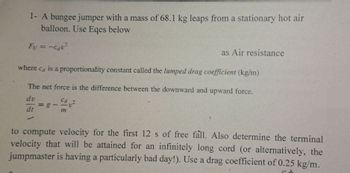
Introduction to Chemical Engineering Thermodynamics
8th Edition
ISBN: 9781259696527
Author: J.M. Smith Termodinamica en ingenieria quimica, Hendrick C Van Ness, Michael Abbott, Mark Swihart
Publisher: McGraw-Hill Education
expand_more
expand_more
format_list_bulleted
Question

Transcribed Image Text:1- A bungee jumper with a mass of 68.1 kg leaps from a stationary hot air
balloon. Use Eqes below
Fu = -cau²
where ca is a proportionality constant called the lumped drag coefficient (kg/m)
The net force is the difference between the downward and upward force.
dv
dt
✓
-
Cd
as Air resistance
m
to compute velocity for the first 12 s of free fall. Also determine the terminal
velocity that will be attained for an infinitely long cord (or alternatively, the
jumpmaster is having a particularly bad day!). Use a drag coefficient of 0.25 kg/m.
Expert Solution
This question has been solved!
Explore an expertly crafted, step-by-step solution for a thorough understanding of key concepts.
This is a popular solution
Trending nowThis is a popular solution!
Step by stepSolved in 3 steps with 2 images

Knowledge Booster
Similar questions
- The speed v at which a rigid sphere falls through a viscous fluid depends on the difference in density between the sphere and the fluid, Ap, the radius of the sphere, a, and the viscosity of the fluid, 7, and is given by 2 gApa? v = 9 where q is the acceleration due to gravity. (a) East Coast beaches are dominated by quartz sand. A medium-sized grain of sand has a radius of 0.5 mm. The density of quartz is 2.65 g/cc (2650 kg/m³); the density of water is about 1 g/cc (1000 kg/m³). The viscosity of water at 20°C is 10-3 Pa s. The acceleration due to gravity is about 9.81 m/s². How long will it take for the grain of sand to sink through 10 m of water? (b) How fast does a sphere of radius 1 cm fall compared to a sphere of radius 0.5 mm in the same fluid? (c) Where a stream enters a pond, it is often observed that coarser sediment such as gravel is deposited near the mouth of the stream, while finer sediments such as sand and silt are deposited farther into the pond. Explain this…arrow_forwardA horizontal 10-cm-diameter jet of water strikes a vertical plate. Determine the velocity issuing from the jet if a force of 1000N is needed to: (1) Hold the plate stationary (2) Move the plate away from the jet at 10 m/s (3) Move the plate into the jet at 10 m/sarrow_forwardA. Suppose a free-fall ride at an amusement park starts at rest and is in free fall. What is the velocity of the ride after 2.3 s? How far do people on the ride fall during the 2.3 s time period?arrow_forward
- As shown in Figure D, three water reservoirs are connected by three pipes. The diameters in each pipe is 1 ft and the Fanning friction factor in each pipe is 0.02. The effective lengths of each pipe are given in the Figure along with other relevant data. Determine the flow rate into or out of each reservoir as well as the Reynolds number in each pipe. (Hint: Start the computations by assuming that the water flows into reservoir B).arrow_forward1. An incompressible fluid of kinematic viscosity v = μ/p= 10-4 m²/s flows steadily through a circular pipe of diameter d = 10 cm. The pipe flow is fully developed. Friction Factor If the average velocity V is 2 m/s, is the flow laminar or turbulent? What is the value of the friction factor, f? If the pipe is perfectly smooth on its internal surface and V is 20 m/s, the pipe flow is turbulent (double check yourself). Evaluate its friction factor using the Moody chart below. Repeat (c) by numerically solving the Colebrook formula (using, for example, Matlab). Attach the source code you used. Suppose that the pipe internal surface is rough. Also suppose that increasing V up to 200 m/s yields no change in the value of f found in (a). Determine the relative roughness, e/d, using the Colebrook formula. 0.1 0.09 0.08 0.07 0.06 0.05 0.04 0.03 0.02 0.015 0.01 Laminar Flow 64 Material Concrete, coarse Concrete, new smooth Drawn tubing Glass, Plastic Perspex Iron, cast Sewers, old Steel, mortar…arrow_forwardI need help with this problemarrow_forward
arrow_back_ios
arrow_forward_ios
Recommended textbooks for you
 Introduction to Chemical Engineering Thermodynami...Chemical EngineeringISBN:9781259696527Author:J.M. Smith Termodinamica en ingenieria quimica, Hendrick C Van Ness, Michael Abbott, Mark SwihartPublisher:McGraw-Hill Education
Introduction to Chemical Engineering Thermodynami...Chemical EngineeringISBN:9781259696527Author:J.M. Smith Termodinamica en ingenieria quimica, Hendrick C Van Ness, Michael Abbott, Mark SwihartPublisher:McGraw-Hill Education Elementary Principles of Chemical Processes, Bind...Chemical EngineeringISBN:9781118431221Author:Richard M. Felder, Ronald W. Rousseau, Lisa G. BullardPublisher:WILEY
Elementary Principles of Chemical Processes, Bind...Chemical EngineeringISBN:9781118431221Author:Richard M. Felder, Ronald W. Rousseau, Lisa G. BullardPublisher:WILEY Elements of Chemical Reaction Engineering (5th Ed...Chemical EngineeringISBN:9780133887518Author:H. Scott FoglerPublisher:Prentice Hall
Elements of Chemical Reaction Engineering (5th Ed...Chemical EngineeringISBN:9780133887518Author:H. Scott FoglerPublisher:Prentice Hall
 Industrial Plastics: Theory and ApplicationsChemical EngineeringISBN:9781285061238Author:Lokensgard, ErikPublisher:Delmar Cengage Learning
Industrial Plastics: Theory and ApplicationsChemical EngineeringISBN:9781285061238Author:Lokensgard, ErikPublisher:Delmar Cengage Learning Unit Operations of Chemical EngineeringChemical EngineeringISBN:9780072848236Author:Warren McCabe, Julian C. Smith, Peter HarriottPublisher:McGraw-Hill Companies, The
Unit Operations of Chemical EngineeringChemical EngineeringISBN:9780072848236Author:Warren McCabe, Julian C. Smith, Peter HarriottPublisher:McGraw-Hill Companies, The

Introduction to Chemical Engineering Thermodynami...
Chemical Engineering
ISBN:9781259696527
Author:J.M. Smith Termodinamica en ingenieria quimica, Hendrick C Van Ness, Michael Abbott, Mark Swihart
Publisher:McGraw-Hill Education

Elementary Principles of Chemical Processes, Bind...
Chemical Engineering
ISBN:9781118431221
Author:Richard M. Felder, Ronald W. Rousseau, Lisa G. Bullard
Publisher:WILEY

Elements of Chemical Reaction Engineering (5th Ed...
Chemical Engineering
ISBN:9780133887518
Author:H. Scott Fogler
Publisher:Prentice Hall


Industrial Plastics: Theory and Applications
Chemical Engineering
ISBN:9781285061238
Author:Lokensgard, Erik
Publisher:Delmar Cengage Learning

Unit Operations of Chemical Engineering
Chemical Engineering
ISBN:9780072848236
Author:Warren McCabe, Julian C. Smith, Peter Harriott
Publisher:McGraw-Hill Companies, The